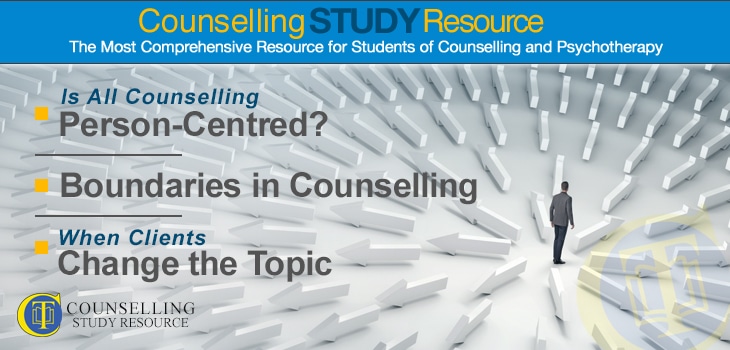066 – Is All Counselling, Person-Centred? – Boundaries in Counselling – When Clients Change the Topic

In episode 66 of the Counselling Tutor Podcast, Ken Kelly and Rory Lees-Oakes ask whether all counselling modalities are based on the person-centred approach. ‘Practice Matters’ then looks at boundaries in counselling. Last, the presenters discuss possible reasons for clients changing the topic in the counselling room.
Is All Counselling Person-Centred? (starts at 1.54 mins)
Is it fair to say that all counselling, whatever the modality, is based on the person-centred approach?
It’s certainly true that the core conditions of empathy, congruence and unconditional positive regard form the basis for most modern therapeutic encounters. Sometimes, these conditions are known by different names – for example, transactional analysis refers to ‘empathic attunement’.
There is wide agreement that the therapeutic relationship is always key, and that the core conditions are universal ingredients of this. The idea of the ‘relational turn’ in counselling and psychotherapy is developed in Transactional Analysis: A Relational Perspective by Helena Hargaden and Charlotte Sills (Routledge, 2002).
Rory and Ken refer to the dodo bird verdict, named after the Alice in Wonderland story in which various characters get wet and the dodo encourages them to run around the lake until they are dry. Nobody measures how far each person runs or for how long. When asked who had won, the dodo replies: ‘Everybody has won and all must have prizes.’ Applied to counselling, the dodo bird verdict suggests that more than 500 different modalities are effective, so long as the therapist has skill and empathy, there is close rapport between the therapist and patient, and there are common therapeutic goals. The concept of the dodo bird verdict was introduced by psychologist Saul Rosenzweig in 1936.
However, in person-centred therapy, there are also an additional three ‘hidden’ conditions, and the full set of six conditions is considered not only necessary but also sufficient for therapeutic personality change. Other modalities, meanwhile, have their own theories and techniques to supplement the core conditions.
Boundaries in Counselling (starts at 12.36 mins)
The Ethical Framework for the Counselling Professions, published in 2015 by the British Association for Counselling & Psychotherapy, requires us to work in line with six core principles: trustworthiness, autonomy, beneficence, non-maleficence, justice and self-respect.
Rory discusses common types of boundary issues in the counselling context, including:
- rescuing – e.g. using sympathy rather than empathy, and assuring the client that everything will be OK
- time management – e.g. cancellation of sessions by the client, or regular lateness
- transference – i.e. the client reminds us of someone from our past, and this affects our boundaries.
You can download Rory’s handout on this topic here, or it is also available in the Handouts Vault and Counselling Study Resource (CSR).
When Clients Change the Topic (starts at 19.37 mins)
For what reasons might a client change the topic? This happens in counselling more than you might think.
Ken and Rory discuss various possible reasons, such as:
- the client not being ready to talk about the issue (perhaps if trust is not yet fully established in the therapeutic relationship)
- it being hurtful or painful for the client to talk about an issue, and so they choose instead to escape to a place of comfort and safety.
In person-centred therapy, we don’t lead the client towards something they are reticent to discuss, but we follow them if they wish to go there themselves. We may, however, comment on their process if they are changing the topic, respectfully challenging this. For example, you could say: ‘I notice that every time I mention [topic], you talk about something else. I’m wondering if that’s a really difficult thing for you to talk about.’
Timing is all. Clients may often wish to work on an issue (hence their presenting for counselling) but find it hard to go there. It can be dangerous to push a client; the most we can ethically do is to invite (but not direct) a client to look at something.


